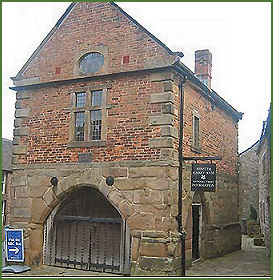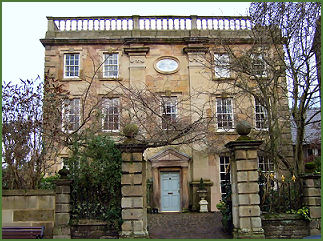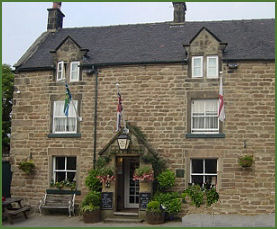Winster
OS Grid ref:- SK241605
 The Peak District village of Winster is situated around 6 miles (10 km) from the town of Bakewell.
The Peak District village of Winster is situated around 6 miles (10 km) from the town of Bakewell.
A ancient settlement, the village is recorded in the Domesday survey as `Winsterne', when it was held by Henry de Ferrers and derives its name from Wynn's Tor, a nearby outcrop of rock on the edge of Bonsall Moor.
Once the centre of the local lead mining industry, Winster is now a designated conservation area, the picturesque village has an array of listed buildings, many of which date from the seventeenth and eighteenth centuries.
 The Market House (pictured left) on the main street is the most prominent buiding in Winster and dates back to the latter half of the sixteenth century, its upper storey is an eighteenth century addition. The lower storey is constructed of gritstone blocks, it's five arches have been filled in, while the brick upper storey was originally timber framed. The building was given to the National Trust in 1906 and was the first property to be acquired by the Trust in the Peak District, it now serves as an information centre.
The Market House (pictured left) on the main street is the most prominent buiding in Winster and dates back to the latter half of the sixteenth century, its upper storey is an eighteenth century addition. The lower storey is constructed of gritstone blocks, it's five arches have been filled in, while the brick upper storey was originally timber framed. The building was given to the National Trust in 1906 and was the first property to be acquired by the Trust in the Peak District, it now serves as an information centre.
Winster Hall, (right) which stands on the north side of the main street, it was built of local gritstone in 1628 by local lead magnate Francis Moore. Legend relates that a daughter of the house fell in love with a servant, and their forbidden affair ended when the two lovers leapt from the parapet of the hall to their deaths. It is said that the forecourt where they fell, is haunted by the ghost of a `White Lady'. In the nineteenth century Winster Hall was the home of historian and antiquary Llewelyn Jewitt, owner, editor and main author of `The Reliquary'.
 Bank House on West Bank, was constructed around 1580 and has traditionally been the home of the village doctor for over 100 years, it was once the home of William Cuddie, one of the last people to be killed in a duel in England (see below for further details).
Bank House on West Bank, was constructed around 1580 and has traditionally been the home of the village doctor for over 100 years, it was once the home of William Cuddie, one of the last people to be killed in a duel in England (see below for further details).
Oddo House to the west of the village church, was the home of the influential Brittlebank family, who once owned most of the village. It was first occupied in 1700 by Hugh Brittlebank, a solicitor.
The village church of St. John the Baptist has an unusual 2 aisled nave which was added in 1833 and which is divided by a lofty arcade. The tower of the building dates from 1721. The Stained glass window in the south wall of the chancel is by Burne-Jones of Morris & Co.
Winster has a number of attractive eighteenth century cottages, which once housed quarry workers and miners.The Old Bowling Green, (pictured left) one of the pubs in the village, dates back to 1472 and offers good food, fine wines, and a range of real ales. The characterful Miner's Standard, was built in 1653 and also serves good food. The pub contains an interesting display of old lead mining equipment.
Winster celebrates various festivals including pancake races at Shrovetide, and Morris dancing during Wake Week, an annual week long festival held each summer, generally at the end of June.
The Winster Duel- one of the last to be fought in England
In May of 1821 Winster was the scene of one the last duels to take place in England. William Cuddie, a 31 year old, popular local surgeon, and had fallen in love with Mary Brittlebank, to the annoyance of her brother, William, a member of the wealthy Brittlebank family of Oddo House. After a heated quarrel regarding the matter, Cuddie received a note stating:-
“Sir, I expect satisfaction for the insult you dared to offer me at a time when you knew that my situation with a helpless Woman prevented my chastising you. Name your time and place, the bearer will wait for an answer. Yours William Brittlebank, Junior. I shall be attended by a friend and prepared with pistols, and if you don’t meet I shall post you as a coward.”
Cuddie did not respond to the letter, but following afternoon the three Brittlebank brothers arrived in his garden with two loaded pistols. Cuddie reluctantly accepted one of the weapons. William Brittlebank walked 15 yards away from his opponent, turned and fired. Two shots were rang out but only Cuddie was hit. He died a few hours later.
Two of the Brittlebanks were later tried in Derby and found not guilty of murder, William Brittlebank fled to Australia with a £100 reward on his head, he never returned to England. William Cuddie was buried in the village churchyard where his grave can still be seen. Mary Brittlebank is believed to have married and moved away but returned to Winster in her later years.
Nearby places of interest
Stanton Moor an upland area rich in prehistoric remains situated between between Matlock and Bakewell.
Chatsworth House known as "The Palace of the Peak" is the country seat of the Duke of Devonshire and is situated on the banks of the River Derwent, 3.5 miles to the northeast of Bakewell in the heart of the Peak District National Park.
Haddon Hall near Bakewell, in the Peak District is an architectural gem. Dating back to the eleventh century, the hall has been described as "the most complete and most interesting house of [its] period", it is the finest example of a medieval manor house currently in existence in England.
Dovedale a dramatic limestone ravine, with its impressive rock outcrops and tranquil woodlands is arguably the prettiest and most famous of the dales in the Peak District National Park
